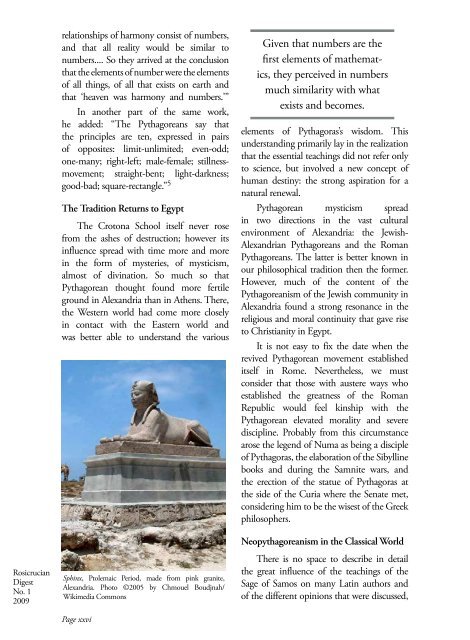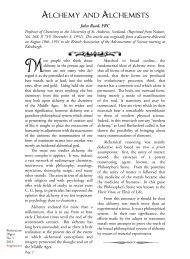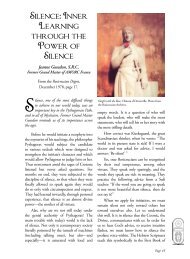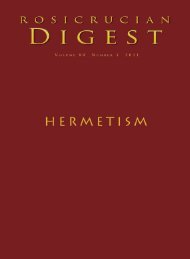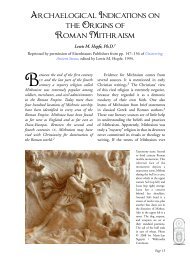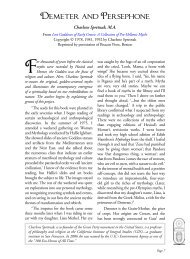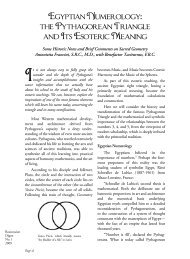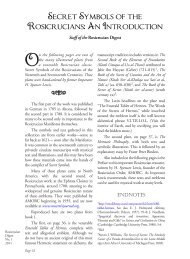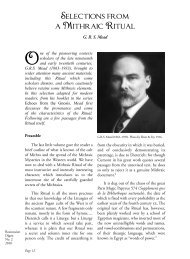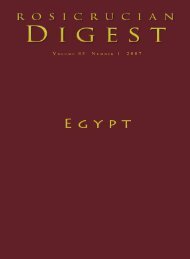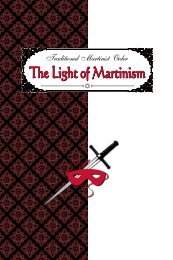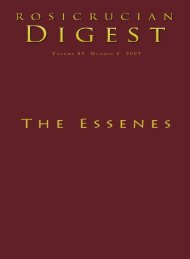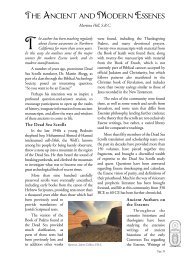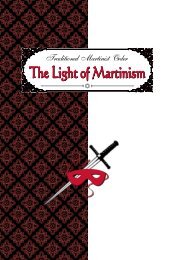Pythagorean Teachings across the Centuries - Rosicrucian Order
Pythagorean Teachings across the Centuries - Rosicrucian Order
Pythagorean Teachings across the Centuries - Rosicrucian Order
You also want an ePaper? Increase the reach of your titles
YUMPU automatically turns print PDFs into web optimized ePapers that Google loves.
elationships of harmony consist of numbers,<br />
and that all reality would be similar to<br />
numbers.... So <strong>the</strong>y arrived at <strong>the</strong> conclusion<br />
that <strong>the</strong> elements of number were <strong>the</strong> elements<br />
of all things, of all that exists on earth and<br />
that ‘heaven was harmony and numbers.’”<br />
In ano<strong>the</strong>r part of <strong>the</strong> same work,<br />
he added: “The <strong>Pythagorean</strong>s say that<br />
<strong>the</strong> principles are ten, expressed in pairs<br />
of opposites: limit-unlimited; even-odd;<br />
one-many; right-left; male-female; stillnessmovement;<br />
straight-bent; light-darkness;<br />
good-bad; square-rectangle.” 5<br />
The Tradition Returns to Egypt<br />
The Crotona School itself never rose<br />
from <strong>the</strong> ashes of destruction; however its<br />
influence spread with time more and more<br />
in <strong>the</strong> form of mysteries, of mysticism,<br />
almost of divination. So much so that<br />
<strong>Pythagorean</strong> thought found more fertile<br />
ground in Alexandria than in A<strong>the</strong>ns. There,<br />
<strong>the</strong> Western world had come more closely<br />
in contact with <strong>the</strong> Eastern world and<br />
was better able to understand <strong>the</strong> various<br />
Given that numbers are <strong>the</strong><br />
first elements of ma<strong>the</strong>matics,<br />
<strong>the</strong>y perceived in numbers<br />
much similarity with what<br />
exists and becomes.<br />
elements of Pythagoras’s wisdom. This<br />
understanding primarily lay in <strong>the</strong> realization<br />
that <strong>the</strong> essential teachings did not refer only<br />
to science, but involved a new concept of<br />
human destiny: <strong>the</strong> strong aspiration for a<br />
natural renewal.<br />
<strong>Pythagorean</strong> mysticism spread<br />
in two directions in <strong>the</strong> vast cultural<br />
environment of Alexandria: <strong>the</strong> Jewish-<br />
Alexandrian <strong>Pythagorean</strong>s and <strong>the</strong> Roman<br />
<strong>Pythagorean</strong>s. The latter is better known in<br />
our philosophical tradition <strong>the</strong>n <strong>the</strong> former.<br />
However, much of <strong>the</strong> content of <strong>the</strong><br />
<strong>Pythagorean</strong>ism of <strong>the</strong> Jewish community in<br />
Alexandria found a strong resonance in <strong>the</strong><br />
religious and moral continuity that gave rise<br />
to Christianity in Egypt.<br />
It is not easy to fix <strong>the</strong> date when <strong>the</strong><br />
revived <strong>Pythagorean</strong> movement established<br />
itself in Rome. Never<strong>the</strong>less, we must<br />
consider that those with austere ways who<br />
established <strong>the</strong> greatness of <strong>the</strong> Roman<br />
Republic would feel kinship with <strong>the</strong><br />
<strong>Pythagorean</strong> elevated morality and severe<br />
discipline. Probably from this circumstance<br />
arose <strong>the</strong> legend of Numa as being a disciple<br />
of Pythagoras, <strong>the</strong> elaboration of <strong>the</strong> Sibylline<br />
books and during <strong>the</strong> Samnite wars, and<br />
<strong>the</strong> erection of <strong>the</strong> statue of Pythagoras at<br />
<strong>the</strong> side of <strong>the</strong> Curia where <strong>the</strong> Senate met,<br />
considering him to be <strong>the</strong> wisest of <strong>the</strong> Greek<br />
philosophers.<br />
<strong>Rosicrucian</strong><br />
Digest<br />
No. 1<br />
2009<br />
Sphinx, Ptolemaic Period, made from pink granite,<br />
Alexandria. Photo ©2005 by Chmouel Boudjnah/<br />
Wikimedia Commons<br />
Page xxvi<br />
Neopythagoreanism in <strong>the</strong> Classical World<br />
There is no space to describe in detail<br />
<strong>the</strong> great influence of <strong>the</strong> teachings of <strong>the</strong><br />
Sage of Samos on many Latin authors and<br />
of <strong>the</strong> different opinions that were discussed,


